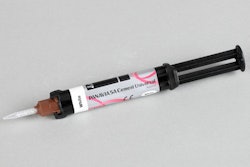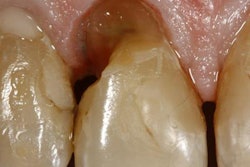
What effect does an erbium-doped yttrium aluminum garnet (Er:YAG) laser have on the binding strengths of glass-fiber posts in root canal treatments? A new in vitro study measured the effect these lasers have on treatment success.
Researchers examined the effect of roughening the root surface using an Er:YAG laser on the binding strength of 90 single-rooted teeth undergoing root canal treatment. Using the laser facilitated disinfection and roughening of the canal (affecting bond strength) and also increased the bonding strength of surface-treated prefabricated glass-fiber posts.
"Use of an Er:YAG laser in the root canal may be beneficial prior to bonding of glass posts," the authors wrote (Medical Science Monitor, January 6, 2018).
The lead author was Zuhal Gorus of the department of prosthodontics at the Harran University Faculty of Dentistry in Şanlıurfa, Turkey.
Bonding time
Lasers can both produce dentin surfaces suitable for bonding of adhesive resin cement and cleanse, shape, and widen the root canal. In conjunction with the laser, the use of a photon-induced photoacoustic streaming (PIPS) tip is another method of cleansing, disinfecting, and shaping the root canal system. This treatment eliminates the need for excessive widening of the root canal, which can weaken the tooth structure.
“Use of an Er:YAG laser in the root canal may be beneficial prior to bonding of glass posts.”
To aid the reincorporation of teeth with previous endodontic treatment, glass-fiber posts are inserted into the root canal. Debridement of the canal also is both mandatory and a major element of endodontic success, according to the authors.
The researchers studied the effect on the bonding strengths of glass-fiber posts with different surface treatments in post spaces roughened by an Er:YAG laser (Fotona Fidelis Plus III laser, Fotona). In addition, they looked at the bonding strengths of prefabricated glass-fiber posts exposed to surface treatments in teeth with excessive substance loss and also the effect of laser treatment of the root canal surface on bond strength.
The study included 90 single-rooted teeth, with 10 teeth each assigned randomly to one of nine groups: control, four treated with a laser, and four without the laser. Teeth with caries, fissures, restoration, dilacerations, or open apices were excluded. The researchers prepared the root canals using a rotary system and standardized the canal length at 14 mm.
Four testing conditions were studied:
- Aluminum oxide particles (CoJet, 3M) 30 µm in diameter were applied to the surface of the glass-fiber post (Abrasive Technology), which was then overspread with silica. A silane primer was then applied to the post surface and dried for five minutes.
- Clearfil Ceramic primer (Kuraray) silane coupling was applied to the post surface and dried for five minutes.
- Hydrofluoric acid was applied to the post surfaces, followed by cementing of the glass post surfaces with primer.
- The post surfaces were sanded with Korox 50 (Bego) before the primer was applied.
The researchers divided each condition into two groups: one group that underwent laser treatment and one group that did not. In addition, they included a control group that had a laser applied to the root canals with no surface treatment of the post. They then subjected eight of the 10 teeth per group to push-out bonding strength testing after treatment.
The team reported that the addition of laser treatment resulted in higher bond strength across the different types of materials (p < 0.005), as indicated in the higher numerical values in the table below:
| Comparison of bond strengths with & without laser treatment | ||
| Groups | Bond strength without laser treatment | Bond strength with laser treatment |
| Control | 113.00 | 113.00 |
| Application of CoJet | 86.20 | 109.90 |
| Application of hydrofluoric acid | 98.27 | 122.37 |
| Sanded | 105.00 | 128.33 |
| Application of Clearfil | 107.73 | 133.33 |
As there have been few previous studies on the Er:YAG laser's impact on mean bond strength values, the researchers noted they were surprised at the difference in values.
"Although the differences in mean bond strength values were statistically significant, this finding was still surprising," the authors wrote.
Laser treatment shows strength
While the authors did not list any study limitations, this was an in vitro study and each group contained only 10 teeth. They did note that further research was necessary.
The researchers concluded that treatment with the laser showed greater bonding strength than treatment without the laser.
"Our results showed that the Er:YAG group ... scored the highest bond strength values compared to the control group," the authors wrote. "Application of the Er:YAG laser to the root canal dentin significantly increased its tensile strength."



















